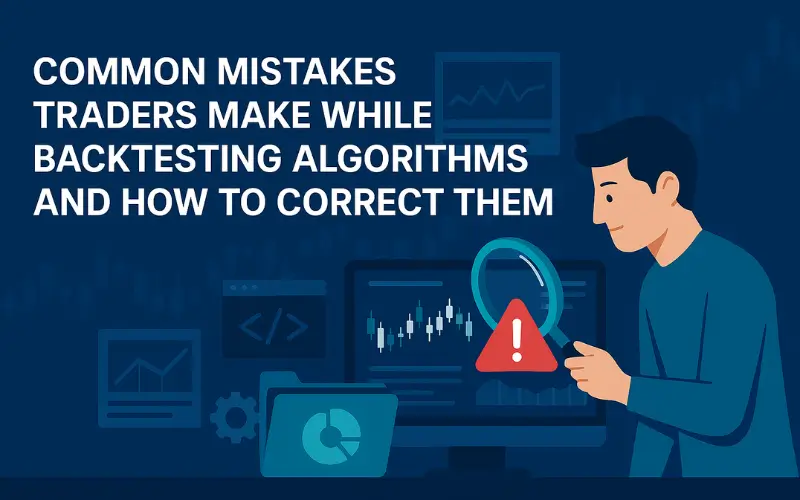Each element of the algorithmic market is constantly changing. For trading systems to function efficiently, it is vital to backtest because it is among the most vital aspects in the development of algorithms. This aids in validating your approach, revealing gaps, and fostering trust before investing money in the muddled markets. However, it is a common misconception that backtesting is flawless; failing to conduct it properly can result in an unwarranted sense of confidence that can subsequently contribute to financial loss.
Novice and professional traders tend to bypass specific steps during the algo backtesting, resulting in misleading outcomes, fine-tuning algorithms to the point of overfitting, and poor performance in real trades. The aim of this blog is to tackle the most common pitfalls traders face while backtesting trades, suggesting straightforward plans to eliminate each one.
Why Is Backtesting Strategically Important?
Before delving into errors, let us summarise the purpose of backtesting strategies.
Backtesting implies applying your algorithm to the historical dataset of a certain market to check how it would have performed in the past. It enables traders to gain insights on how a strategy reacts to diverse market situations and allows them to fine-tune the strategy before putting actual money at stake.
However, this benefit is only useful when backtesting is done correctly. This is where most people fail.
1. Overfitting the Strategy to Historical Data
What It Means: Overfitting refers to a situation where a strategy performs exceptionally well in backtesting due to being tailored to historical anomalies and noise, but fails to deliver in live trading. This is because the strategy fails to withstand changes in the market.
Why It’s Dangerous: Strategies that are overfit do not perform well when subjected to new data, which translates to real life. This is akin to students who ace exams due to most templates, not thinking beyond class rote.
How to Avoid It:
- Use out-of-sample testing: Partition your data into training (for illustration, split 2013-2020) and test set (2021-2023).
- Adopt more general approaches to avoid a boundless set of parameters.
- Use walk-forward optimisation to better model live trading adjustments.
2. Employing Look-Ahead Bias
What It Means: Look-ahead bias happens when unattained information is used to forecast results. For instance, in a historical simulation, the format would have the data in the way it is shown to ‘read’ it during trading. Your strategy receives information that it would not have available during the period of trading.
Example: Estimating a moving average using future price data or trading off future price data.
How to Avoid It:
- Employ only data available when the trade was completed.
- Remember to validate the logic and code of your backtest.
- Use Backtester and QuantConnect, which are two backtesting software that are known for their accuracy.
3. Not Accounting for Costs: Transactions, Slippage, and Liquidity
What It Means: Backtesters fail to consider real-life spreads, commission fees, slippage, and even low-volume problems. Strategies that seem to be accurate could be disastrous if the costs exceed the benefits.
How to Avoid It:
- Integrate realistic costs into the model.
- Do not trade in low-volume components unless slippage is added.
- Do not trade in assets that change their spreads rapidly unless your strategy can handle it.
4. Curve Fitting to a Specific Timeframe or Market Condition
What It Means: Your strategy is too rigid because it is optimised for a certain market condition, such as bullish markets, which result in losses when the market shifts.
Example: From 2020 to 2021, a breakout strategy was inherently backtested, which means that it might perform poorly during bearish or sideways conditions.
How to Avoid it:
- Ensure that your strategy is tested over a series of market cycles: bullish, bearish, and sideways.
- Historical data should span a minimum of 7-10 years.
- Your testing should also include extreme events, for example, the 2008 market crash or the COVID-19 downturn in 2020.
5. Absence of Varied Testing
What It Means: The impression of a robust backtested strategy can be formed solely through relying on a single stock, asset class or singular time frame, which is incorrect.
How to Avoid It:
- Test the strategies across various asset classes: stocks, commodities, crypto, and forex.
- Using a range of time frames from intraday to daily and weekly will allow you to gauge behaviour.
- Ensure to evaluate a range of symbols to eliminate the possibility of instrument tailoring.
6. Small Sample Size
What It Means: A lack of construct validity is evident when insufficient trades or short time frames are used for backtesting.
For example, using a heuristic sampling approach where a strategy is tested with a mere 30 trades over three months is statistically insignificant and therefore will garner unreliable results.
How To Avoid It:
- Obtain a minimum of 300 trades to ensure that intelligent reflections can be parsed from the data.
- Pay attention to citing a respectably diverse sample of market fluctuations during the sample period.
- Monitor the confidence intervals and apply Monte Carlo methods for fortification testing.
7. Not Accounting For Data Quality Issues
What It Means: Perhaps the most critical issue is not considering the data’s accuracy. Using non-validated datasets is ripe with risk and can be potentially misleading.
How To Avoid It:
Always use verified quantitative data provided by backtesting software platforms such as QuantConnect, MetaTrader 5, or Amibroker.
8. Misinterpreting The Metrics
What It Means: Focusing on only metrics such as the total return may be misleading when taken in adequate context. Appropriate metrics to focus on include:
Sharpe Ratio: Adjusted return for risk.
Max Drawdown: Largest peak-to-trough loss.
Win/Loss ratio: How often a strategy scores a win versus takes a hit.
How to Avoid It:
Be focused on the quality of your efforts. Ask yourself: Would I be comfortable holding during the worst drawdown indicated here?
9. Skipping Forwards Testing or Paper Trading
What It Means: Moving from backtesting to live trading without intermediary steps increases the chances of encountering unwelcome surprises.
How to Avoid It:
Use demo or paper accounts for at least 1-2 months. Track real-time performance and measure it against the benchmarks set in backtesting. Revision and iteration are essential based on real-time actions prior to utilising capital.
Final Thoughts: Backtesting Done Right Is a Superpower
Backtesting trading strategies is one of the most useful methods for instilling trust and navigating the uncertainty of algo trading—if done wrong, consciously or unconsciously, it can be worse than not testing at all. Instead of providing clarity, it creates a false sense of security, leading to failure. Always remember: Quality data paired with the best backtesting software ensures successful strategising. Prevent concept overfitting, look-ahead bias, and make-believe assumptions. Over the backtesting period, strategies should be validated multiple times through various metrics and market states, both as bull and bear conditions.
Remember, those who backtest extensively have the most success. In short, proficient traders meticulously plan, test, calibrate, and adapt. They avoid the blunders outlined earlier. As you work to improve your system by avoiding these errors, you are also protecting your capital, your confidence, and your enduring prosperity. Algo trading lesson: The best back testers become the best traders.




